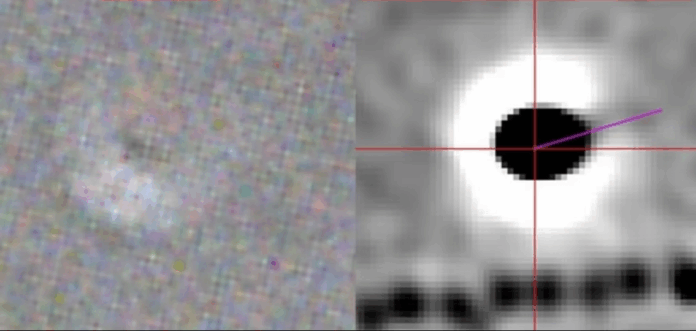
Private citizen using solar telescope documents unusual structural features on interstellar visitor, raising questions about object’s shape and composition as NASA remains offline
By Samuel Lopez | USA Herald
USA HERALD — In a striking demonstration of citizen science filling institutional voids, private astronomer Dobsonian Power captured what may be among the final clear images of interstellar object 3I/ATLAS on October 20, 2025, just hours before the comet disappeared behind the Sun from Earth’s vantage point.
Working from coordinates provided by NASA’s Jet Propulsion Laboratory, Dobsonian Power used a solar telescope to track and photograph the rapidly moving object as it approached solar conjunction. The timing proved critical: with NASA’s public outreach and data distribution severely limited by the ongoing government shutdown, independent observers have become the primary source of real-time information about one of only the third confirmed interstellar object ever detected in our solar system.
“It has something in the middle… You see this kind of a cone or something here,” Dobsonian Power noted in his video documentation, pointing to unusual structural features in the raw, unprocessed capture.
The amateur astronomer’s imagery reveals formations distinctly different from the tails or anti-tails typically associated with cometary bodies. When compared side-by-side with recent European Space Agency photographs of 3I/ATLAS, the discrepancies raise intriguing questions about the object’s composition, orientation, shape and behavior as it navigates the inner solar system.
Dobsonian Power emphasized that his captures represent raw data—no image manipulation, stacking, or digital enhancement—simply direct snapshots from live telescope feeds. This methodology, while producing grainier results than professional observatory equipment, offers an unfiltered view that some researchers argue provides valuable complementary data to heavily processed institutional imagery.
The convergence of federal budget constraints and a rare astronomical event has unexpectedly elevated the role of amateur observers. While organizations like NASA and ESA operate sophisticated space-based and ground-based telescope arrays worth hundreds of millions of dollars, those systems provide little public value when political dysfunction prevents the dissemination of their findings.
“No matter how modern and complex the telescopes, space rovers, satellites, and high-powered Earth-based instruments that space agencies control, there is still a critical need for citizen astronomers to continue monitoring our skies,” noted James Wes, an astronomy education advocate.
These citizen observers, who often possess advanced degrees and specialized knowledge, can maintain continuity of public scientific discourse even when institutional channels go dark.
The 3I/ATLAS event has galvanized amateur astronomy communities worldwide, with hundreds of observers attempting to document the object before it became inaccessible. The collaborative nature of this effort—sharing coordinates, techniques, and findings across international borders—represents a decentralized approach to scientific observation that operates independently of government funding cycles.
For context, 3I/ATLAS joins only two other confirmed interstellar visitors: 1I/’Oumuamua (discovered 2017) and 2I/Borisov (discovered 2019). Each has challenged existing models of how such objects behave, with ‘Oumuamua’s unusual acceleration and Borisov’s surprisingly familiar cometary characteristics both defying initial predictions.
The unusual features documented in Dobsonian Power’s latest captures add another layer of intrigue to 3I/ATLAS’s profile. Professional astronomers with access to archived institutional data will eventually be able to compare these citizen observations with classified or embargoed professional captures, potentially validating or contextualizing what amateur equipment has revealed.


